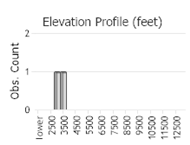View in other NatureServe Network Field Guides
NatureServe
Montana
Utah
Wyoming
Idaho
Wisconsin
British Columbia
South Carolina
Yukon
California
New York
A Pseudocrossidium Moss - Pseudocrossidium obtusulum
General Description
Plants: Crowded erect shoots forming cushions or turfs, lime-green or brown above, more reddish-brown below. Stems up to 20 mm; axillary hairs present with 5-8 hyaline cells (FNA 2007).
Leaves: Stem leaves flat to the stem and overlapping when dry, more-or-less spreading when wet, ovate to somewhat triangular, 0.7-1.2 mm in length; margins rolling downwards and inwards strongly, making 1 or nearly 2 revolutions; apex widely acute; costa forming an apiculus, the costa’s outer surface near mid-leaf convex in X-section (FNA 2007).
Leaf Cells: Lower laminal cells rectangular; upper laminal cells 1:1; costa X-section with 2-3 guide cells in 1 or 2 layers, the adaxial cells quadrate or longer on one side (FNA 2007).
Phenology
Capsules ripen in early summer (June) (FNA 2007).
Diagnostic Characteristics
Although Didymodon brachyphyllus has a similar appearance to P. obtusulum, its margins are simply strongly revolute and its apex indistinct (somewhat blunt, frequently tipped with an apiculus of 1-3 cells). The margins of P. obtusulum make one to nearly two full revolutions, and its leaf tip is apiculate from the excurrent costa (FNA 2007).
Range Comments
In North America, occurring in AK and YT, s to CA, and also in NU, MT, and NM; Greenland and Europe (FNA 2007). Known in Montana from Ravalli County (Elliott and Pipp 2016).
Observations in Montana Natural Heritage Program Database
Number of Observations: 3
(Click on the following maps and charts to see full sized version)
Map Help and Descriptions
Relative Density

Recency



 (Observations spanning multiple months or years are excluded from time charts)
(Observations spanning multiple months or years are excluded from time charts)
Habitat
Calcareous soils at low to moderate elevations (about 100-3610 feet) (FNA 2007) in grassland and steppe vegetation (Elliott and Pipp 2016).
Reproductive Characteristics
Dioicous. Seta 10-20 mm tall. Capsules 1-2 mm in length; peristome with 32 yellow teeth, straight or wound counterclockwise for half of a turn, normally shedding with the operculum; operculum cone-shaped with a beak (FNA 2007).
Asexual reproduction sometimes occurs via spherical or club-shaped gemmae produced on the costa’s outer surface, or as propagules borne on the rhizoids (FNA 2007).
Stewardship Responsibility
References
- Literature Cited AboveLegend:
 View Online Publication
View Online Publication Elliott, J.C. and A.K. Pipp. 2018. A Checklist of Montana Mosses (1880-2018). Updated 3 January, 2020. Montana Natural Heritage Program, Helena, Montana. 73 pp.
Elliott, J.C. and A.K. Pipp. 2018. A Checklist of Montana Mosses (1880-2018). Updated 3 January, 2020. Montana Natural Heritage Program, Helena, Montana. 73 pp. Flora of North America Editorial Committee, eds. 2007. Flora of North America North of Mexico. Volume 27. Bryophytes: Mosses, Part 1. Oxford University Press, Inc., NY. xxi + 713 pp.
Flora of North America Editorial Committee, eds. 2007. Flora of North America North of Mexico. Volume 27. Bryophytes: Mosses, Part 1. Oxford University Press, Inc., NY. xxi + 713 pp.
- Additional ReferencesLegend:
 View Online Publication
View Online Publication
Do you know of a citation we're missing? Elliot, J. C. 1993. Second checklist of Montana mosses. Unpublished report. U.S. Forest Service, Region 1. Missoula, MT. 45 pp.
Elliot, J. C. 1993. Second checklist of Montana mosses. Unpublished report. U.S. Forest Service, Region 1. Missoula, MT. 45 pp. Lawton, E. 1971. Keys for the Identification of the Mosses on the Pacific Northwest. Reprinted from 'Moss Flora of the Pacific Northwest'. Published as Supplement No. 2 of the Journal of the Hattori Botanical Laboratory. Nichinan, Miyazaki, Japan. 66 pp.
Lawton, E. 1971. Keys for the Identification of the Mosses on the Pacific Northwest. Reprinted from 'Moss Flora of the Pacific Northwest'. Published as Supplement No. 2 of the Journal of the Hattori Botanical Laboratory. Nichinan, Miyazaki, Japan. 66 pp. Lawton, E. 1971. Moss Flora of the Pacific Northwest. Hattori Botanical Laboratory. Japan: Yamabuki-cho, Shinjuku-ku, Tokyo. 362 pages plus appendices.
Lawton, E. 1971. Moss Flora of the Pacific Northwest. Hattori Botanical Laboratory. Japan: Yamabuki-cho, Shinjuku-ku, Tokyo. 362 pages plus appendices.
- Web Search Engines for Articles on "A Pseudocrossidium Moss"





